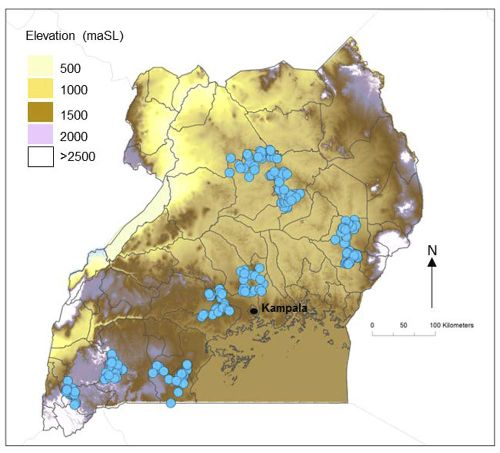OR/17/029 Survey 1, Uganda
| Owor M, MacDonald A M, Bonsor H C, Okullo J, Katusiime F, Alupo G, Berochan G, Tumusiime C, Lapworth D, Whaley L, Lark R M. 2017. UPGro Hidden Crisis Research Consortium — Survey 1 Country Report–Uganda . British Geological Survey Internal Report, OR/17/029. |
 |
Survey 1 in Uganda was conducted from 4th to June 15th September 2016. A total of 200 boreholes across ten districts were surveyed: three of the districts were in Central Region (Luwero, Mityana, Rakai), two in the Western Region (Mbarara, Rukungiru), three in the Northern Region (Dokolo, Lira, Oyam) and two in the Eastern Region of the country (Budaka, Kumi) – Figure 2. Physical characteristics of the districts included in Survey 1 are summarised in Table 1.
Site selection. The water points in Survey 1 were chosen by a stratified two-stage random sampling design. The domain to be sampled comprised those Districts across Uganda where sampling was deemed practicable by WaterAid. There are 112 Districts in Uganda and 25 were were regarded as feasible to sample, and these constitute the sampling domain. Districts were used as primary sample units and were randomly chosen from within each of four strata defined with respect to hydrogeology (sedimentary or basement rocks) and poverty (above or below Uganda median). Twenty villages were then randomly chosen from within each District. At each village, the community made a list of all the hand pump boreholes they had access to as a community and then one of these was randomly chosen to sample.
The relative size of each stratum was computed from the numbers of shallow water points recorded in the national water supply database. To account for differences between the 25 Districts in the sampling domain and all 112 Districts within Uganda, the results presented below are computed from stratum sample means and the relative size of the strata over all villages in Uganda. Treating these as an estimate for this entire domain, as opposed to the original domain of Districts available for sampling, assumes that the Districts in the sample domain are a random sample drawn from all districts.
Survey methods. HPB’s were surveyed for water quality, microbiology, pumping test, users perception of the HPB functionality performance and the experience and capacity of community management arrangements.
Survey team. The Survey Team in Uganda was led by Makerere University, and was supported by: WaterAid Uganda, who played a key part in facilitating the fieldwork; and, the ten District Water Bureau’s, which helped facilitate access to communities, and assisted the survey team. Training and guidance throughout the Survey was provided by BGS and Sheffield University, UK.

| District | Regional state | Distance from Kampala (km) | Av. Elevation (mamsl) | Mean annual rainfall (mm) | Mean annual temp. (°C) | Dry months |
| Budaka | Eastern | 185 | 1152 | 1010 | 22.3 | None |
| Dokolo | Northern | 195 | 1000 | 1050 | 22.5 | None |
| Kumi | Eastern | 195 | 1050 | 1150 | 22.5 | None |
| Lira | Northern | 210 | 1090 | 1434 | 23.3 | None |
| Luwero | Central | 50 | 1100 | 1157 | None | |
| Mbarara | Western | 250 | 1400 | 905 | 22.7 | None |
| Mityana | Central | 60 | 1220 | 1100 | 21.5 | None |
| Oyam | Northern | 240 | 1080 | 1150 | 22.7 | One |
| Rakai | Central | 160 | 1200 | 1117 | 22.8 | None |
| Rukungiru | Western | 320 | 1550 | 850 | 23 | None |